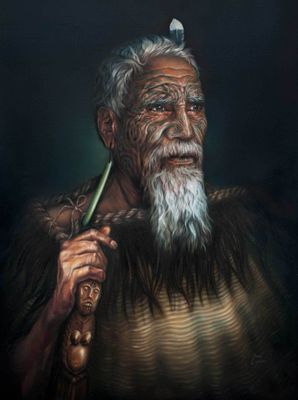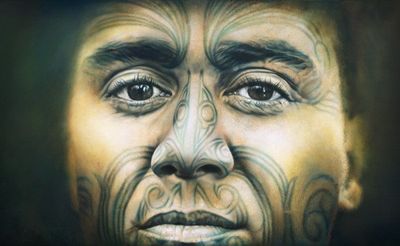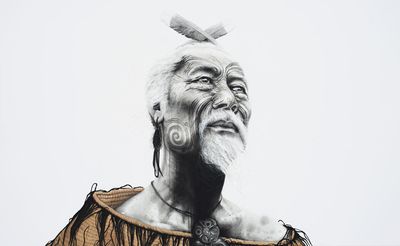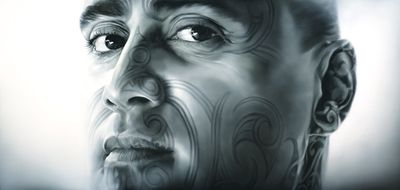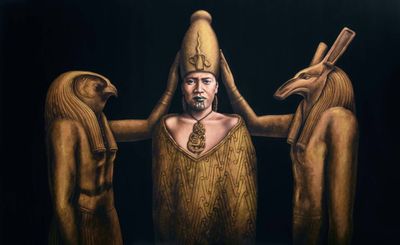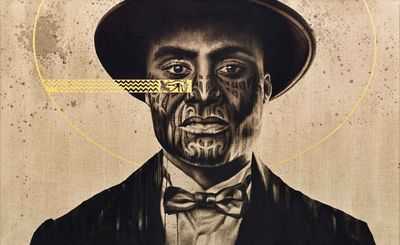
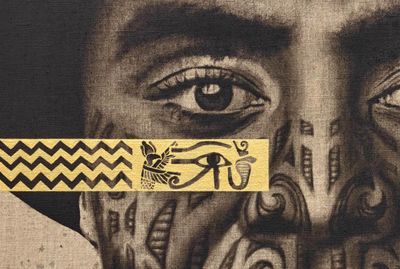
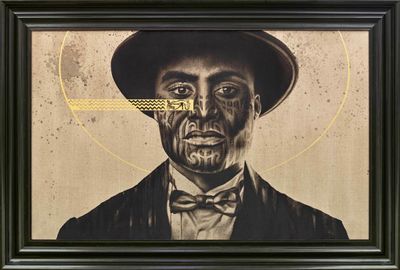
Horus
$8,750.00
Explore the story of the artwork >>
Print sizes and editions
Extra Large museum canvas print - 840 x 1361mm SOLD OUT (only a couple of Artist Proofs left - enquire to purchase)
Print sizes and editions
- Regular museum archival paper print - 500 x 810mm
(limited to 95) - Large museum archival paper print - 679 x 1110mm
(limited to 95) - Extra Large museum canvas print - 840 x 1361mm
(limited to 95)
Your unique limited edition fine art print
- Sofia Minson creates your exclusive signed print
- We ship for $25 in NZ and from $50 internationally
- Your artwork arrives rolled, ready to be framed - do you need help? Request framing guidance
The story of Horus
This portrait of a young man with a bow tie and bowler hat fuses Western, Māori and Egyptian traditions together.
Horus is part of Sofia Minson's 2018 series of work entitled The Navigators.
His form was inspired by dozens of 19th-century black and white photographs of Māori, pieced together to become something entirely new in the process.
A stark contrast
The Victorian outfit is in stark contrast to his Moko Kanohi (face tattoo). Moko is an indelible link to whakapapa (lineage), going all the way back to cosmic origins.
Aotearoa's colonial period, in which Māori and British clashed, was handed to younger generations who had no choice but to transform it and make the best of their lives in a new world.
This man has great mana or dignity. He looks as though he has taken the pain and competing traditions of the past and created a new stable centre of Self for the future. This is a spiritual, alchemical evolution.
Son of Osiris and Isis
In this way, I see him as embodying the myth of Horus, the falcon-headed god in ancient Egypt. The son of Osiris and Isis.
Osiris was a great king who represented the establishment of the Egyptian state. Like all institutions he became old and willfully blind, refusing to see new dangers and adapting with the times.
Osiris turned a blind eye to Seth, his evil brother, who was plotting to take the reigns of the kingdom. When Osiris wasn't paying attention, Seth attacked the old king, chopping him into many pieces and distributing them all over Egypt.
The creation of Horus
But Osiris can never be completely destroyed. The spirit of Osiris, which is culture and tradition, is in all the pieces.
Isis is the queen of the underworld. She is the chaos that emerged when Egypt was struggling and adrift without their king. She found the phallus of Osiris and impregnated herself, giving birth to Horus.
Seeing with perspective
Horus has the crucial ability to see with perspective, like a falcon in flight. He is the son of the great mother and father - a messianic figure who parallels Christ. Horus grew up outside the kingdom in the underworld with his mother, alienated from his fundamental culture. This is the classic story of childhood and adolescence.
He decided to battle his uncle Seth to try and get the kingdom back. He won but in the process, his eye was ripped out. The hero's journey across cultures and throughout time seems to suggest that it is far better to face evil and "slay the dragon" voluntarily, but even still, you are bound to get injured.
An embodiment of the past and present
Horus went down to the underworld and gave the old, blind king his eye. Together, they returned to the world, embodying the best of past and present. The pharaoh represents this Osiris and Horus partnership. The ruler must be awake to malevolence and revitalise the traditions of his ancestors.
The figure of the restored eye of Horus (the wedjat eye) became a powerful symbol of heightened awareness and inner vision.
Explaining the hieroglyph
The gold zigzag pattern coming across Horus' face is the hieroglyph for water. The ocean is a mysterious world of the deep. Here it represents Horus' trip to the underworld to return sight to his father.
The winged, falcon-headed god Horus in this symbol carries the eye of wedjat, lead by a uraeus (rearing cobra). The serpent is symbolic of kundalini energy rising through the spine activating the third eye.
Horus' moko
The vertical laddering effect of the moko references woven tukutuku panels in marae (meeting houses) and suggests a pathway between our realm and the gods.
The laddering is interrupted in places with curved, koru patterns. These are yin (feminine) in nature, representing the unfolding creation of the material world. As Christ on the centre of the cross, the idea is to be both vertically aligned towards divinity and horizontally connected to this earthly realm.
Select your print >>
Original painting SOLD, flashe (vinyl paint) on linen. 1280 x 1900mm (including frame), 2018
Sofia Minson Paintings | New Zealand Artwork
